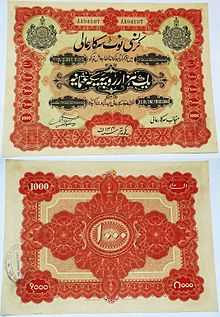Waterlow and Sons
| Former type | Private Limited Company |
|---|---|
| Industry | Secure printing |
| Fate | Acquired (1961), Dissolved (2009) |
| Successor(s) | De La Rue |
| Founded | 1810 |
| Defunct | 2009 |
| Headquarters | UK |
| Products | Banknotes |


Waterlow and Sons Limited was a major worldwide engraver of currency, postage stamps, stocks and bond certificates based in London, Watford and Dunstable in England. The company was founded as a family business in 1810. It was acquired in 1961 by De La Rue.
Early history
Waterlow and Sons originated from the business of James Waterlow, who began producing lithographic copies of legal documents at Birchin Lane in London in 1810. The company gradually grew; it began printing stamps in 1852, and Waterlow' sons Alfred, Walter, Sydney and Albert joined the business. James Waterlow died in 1876, and the company became a limited-liability company. In 1877, due to a family dispute, the company split, and Alfred and his sons formed Waterlow Bros. & Layton. The two companies later reunited in 1920.[1][2]
Portuguese banknote crisis
Waterlow's was involved in the Portuguese Bank Note Crisis of 1925. The Banco de Portugal sued Waterlow & Sons in the High Court in London because of counterfeiting. In one of the most complex trials in legal history, the case was finally settled in favour of the Bank in 1932.[3]
Bank of England banknotes
In 1921 the Bank of England gained a legal monopoly on the issue of banknotes in England and Wales, a process that started with the Bank Charter Act of 1844 when the ability of other banks to issues notes was restricted.
On 22 November 1928 the Bank issued notes for ten shillings and one pound for the first time when the Bank took over responsibility for these denominations from the Treasury which had issued notes of these denominations three days after the declaration of war in 1914 in order to remove gold coins from circulation. The treasury bills had been printed by Waterlows, and the loss of the contract contributed to the closure of Waterlow's operations at Milton Street in Watford.[4]
De La Rue ownership
Waterlow's was acquired by Purnell and Sons in 1961, but Purnell sold Waterlow's segment that printed banknotes, postage stamps, traveler's checks, and bonds to De La Rue soon after.[5]
In 2003 De La Rue acquired the banknote printing operations of the Bank of England,[6] 75 years after Waterlow's had lost the business.
Waterlow and Sons Ltd was dissolved in January 2009.[7]
Gallery of the work of Waterlow and Sons
Gallery
-

Modderfontein B. Gold Mines Limited dividend coupon. (c. 1900)
-

Stamps of North Borneo. (1911)
-
Revenue stamps of Bolivia.
References
- ↑ "Waterlow and Sons Limited". NMSI. National Museums of Science & Industry. Retrieved 10 March 2012.
- ↑ "Waterlow and Sons: 1934 Review". Grace's Guide. Grace's Guide. Retrieved 10 March 2012. Based on "Printing by Every Process". British Commerce and Industry: The Post-War Transition 1919–1934. Russell-Square Press. 1934.
- ↑ Wigan, Henry (February 2004). "The Effects Of The 1925 Portuguese Bank Note Crisis". Department of Economic History, London School of Economics. Retrieved 2009-03-26.
- ↑ Nunn, JB (1987). The Book of Watford. Watford: Pageprint (Watford) Ltd. ISBN 0-9511777-1-0. p171
- ↑ Bloom, Murray Teigh (1966). The Man Who Stole Portugal. New York: Charles Scribner's Sons.
- ↑ Bank of England: Sale of Bank Note Printing Operations
- ↑ "Company Details". Companies House. Companies House. Retrieved 10 March 2012.
Further reading
- Williams, L. N. and M. A Century Of Stamp Production, 1852-1952. London: Waterlow & Sons, Limited, 1952 44p.
External links
| Wikimedia Commons has media related to Waterlow & Sons. |
- Ticket Printing Machine - Waterlow & Sons, 1920-1940. Museum Victoria.
- 1959 Waterlow Ultra Ticket Printing Machine
